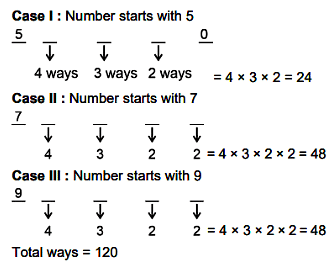N>40000, where N is divisible by 5. How many such 5 digit numbers can be formed using 0,1,3,5,7,9 without repetition.
Approach Solution - 1
The correct answer is 120.

Approach Solution -2
We are to form 5-digit numbers using the digits {0, 1, 3, 5, 7, 9} without repetition, under two conditions:
- The number must be greater than 40,000.
- The number is divisible by 5 (i.e. its last digit must be 0 or 5)
Case 1: Last Digit is 0
With the last digit fixed as 0, the first digit cannot be 0 and must make the number > 40,000. The available digits for the first position (excluding 0) are {1, 3, 5, 7, 9}. Since the number must be > 40,000, the first digit must be at least 4. Among our choices, only 5, 7, and 9 qualify.
Number of choices for the first digit: 3.
After fixing the first and last digits, there remain 4 digits for the three middle positions. The number of ways to fill these positions is:
P(4, 3) = 4 × 3 × 2 = 24
Total numbers for Case 1: 3 × 24 = 72.
Case 2: Last Digit is 5
With the last digit fixed as 5, the first digit must be chosen from the remaining digits {0, 1, 3, 7, 9} (0 is not allowed in the first position) and must be at least 4 to ensure the number is > 40,000. This leaves only 7 and 9.
Number of choices for the first digit: 2.
The remaining three positions (the 2nd, 3rd, and 4th digits) can be filled from the 4 remaining digits (from a total of 6, after fixing the first and last digits) in:
P(4, 3) = 4 × 3 × 2 = 24
Total numbers for Case 2: 2 × 24 = 48.
Total Count
Total 5-digit numbers = 72 + 48 = 120.
Top Questions on permutations and combinations
- The number of different 5 digit numbers greater than 50000 that can be formed using the digits 0, 1, 2, 3, 4, 5, 6, 7, such that the sum of their first and last digits should not be more than 8, is:
- JEE Main - 2025
- Mathematics
- permutations and combinations
If all the words with or without meaning made using all the letters of the word "KANPUR" are arranged as in a dictionary, then the word at 440th position in this arrangement is:
- JEE Main - 2025
- Mathematics
- permutations and combinations
The number of 6-letter words, with or without meaning, that can be formed using the letters of the word MATHS such that any letter that appears in the word must appear at least twice, is $ 4 \_\_\_\_\_$.
- JEE Main - 2025
- Mathematics
- permutations and combinations
- If the number of seven-digit numbers, such that the sum of their digits is even, is $ m \cdot n \cdot 10^a $; $ m, n \in \{1, 2, 3, ..., 9\} $, then $ m + n $ is equal to
- JEE Main - 2025
- Mathematics
- permutations and combinations
- Group A consists of 7 boys and 3 girls, while group B consists of 6 boys and 5 girls. The number of ways, 4 boys and 4 girls can be invited for a picnic if 5 of them must be from group A and the remaining 3 from group B, is equal to:
- JEE Main - 2025
- Mathematics
- permutations and combinations
Questions Asked in JEE Main exam
- Given below are two statements. One is labelled as Assertion (A) and the other is labelled as Reason (R).
Assertion (A): Refractive index of glass is more than air.
Reason (R): Optical density of a medium is directly related to its mass density.
In the light of the above statements, choose the correct answer from the options given below.- JEE Main - 2025
- Refractive index
- Ice at \( -5^\circ C \) is heated to become vapor with temperature of \( 110^\circ C \) at atmospheric pressure. The entropy change associated with this process can be obtained from:
- JEE Main - 2025
- Thermodynamics
A conducting bar moves on two conducting rails as shown in the figure. A constant magnetic field \( B \) exists into the page. The bar starts to move from the vertex at time \( t = 0 \) with a constant velocity. If the induced EMF is \( E \propto t^n \), then the value of \( n \) is _____.

- JEE Main - 2025
- Magnetic Field
- Concentrated nitric acid is labelled as 75%by mass. The volume in mL of the solution which contains 30 g of nitric acid is: Given: Density of nitric acid solution is 1.25 g/mL.
- JEE Main - 2025
- Solutions
- A physical quantity \( Q \) is related to four observables \( a \), \( b \), \( c \), and \( d \) as follows: \[ Q = \frac{a b^4}{c d^2} \] Where:
- \( a = (60 \pm 3) \, \text{Pa} \),
- \( b = (20 \pm 0.1) \, \text{m} \),
- \( c = (40 \pm 0.2) \, \text{N·s/m}^2 \),
- \( d = (50 \pm 0.1) \, \text{m} \).
Then the percentage error in \( Q \) is:- JEE Main - 2025
- Error analysis
Concepts Used:
Permutations
A permutation is an arrangement of multiple objects in a particular order taken a few or all at a time. The formula for permutation is as follows:
\(^nP_r = \frac{n!}{(n-r)!}\)
nPr = permutation
n = total number of objects
r = number of objects selected
Types of Permutation
- Permutation of n different things where repeating is not allowed
- Permutation of n different things where repeating is allowed
- Permutation of similar kinds or duplicate objects